The "locked-room" or "impossible crime" mystery is a type of crime seen in crime and detective fiction. The crime in question, typically murder, is committed in circumstances under which it was seemingly impossible for the perpetrator to commit the crime or evade detection in the course of getting in and out of the crime scene. The crime in question typically involves a crime scene with no indication as to how the intruder could have entered or left; for example, a victim found deceased in a windowless room that is sealed from the inside at the time of discovery. Following other conventions of classic detective fiction, the reader is normally presented with the puzzle and all of the clues, and is encouraged to solve the mystery before the solution is revealed in a dramatic climax.

The Clock in the Hatbox is a 1939 mystery detective novel by Anthony Gilbert, the pen name of British writer Lucy Beatrice Malleson. It is the fifth in her long-running series featuring the shady London lawyer and detective Arthur Crook. It was published during the Golden Age of Detective Fiction. Reviewing it for the Times Literary Supplement, Maurice Percy Ashley noted "The tale is very fairly told. Mr. Gilbert, whose work has not perhaps always been sufficiently appreciated in the past, has written a thoroughly entertaining story".

The Bell of Death is a 1939 mystery detective novel by Anthony Gilbert, the pen name of British writer Lucy Beatrice Malleson. It is the sixth in her long-running series featuring the unscrupulous London lawyer and detective Arthur Crook. It was published during the Golden Age of Detective Fiction. Reviewing it for the Times Literary Supplement, Maurice Percy Ashley commented "as usual with Mr. Gilbert’s stories this is exciting and well written, but it is so complicated that the reader can do little more than hold his breath".

The Man Who Wasn't There is a 1937 mystery detective novel by Anthony Gilbert, the pen name of British writer Lucy Beatrice Malleson. It is the second in her long-running series featuring the unscrupulous London solicitor and detective Arthur Crook.

Murder Has No Tongue is a 1937 mystery detective novel by Anthony Gilbert, the pen name of British writer Lucy Beatrice Malleson. It is the third in her long-running series featuring the unscrupulous London solicitor and detective Arthur Crook.
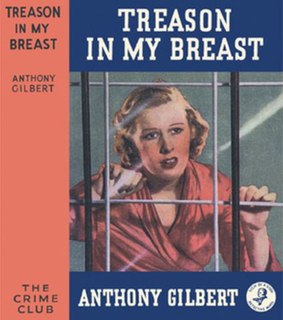
Treason in My Breast is a 1938 mystery detective novel by Anthony Gilbert, the pen name of British writer Lucy Beatrice Malleson. It is the fourth in her long-running series featuring the unscrupulous London solicitor and detective Arthur Crook. Crook became one of the established characters of the Golden Age of Detective Fiction, although in this case the novel was more similar to a Victorian melodrama than a conventional whodunnit.
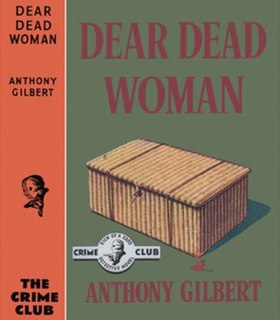
Dear Dead Woman is a 1940 mystery detective novel by Anthony Gilbert, the pen name of British writer Lucy Beatrice Malleson. It is the seventh in her long-running series featuring the unscrupulous London solicitor and detective Arthur Crook. In 1942 it was published in America under the alternative title Death Takes a Redhead.

The Musical Comedy Crime is a 1933 mystery detective novel by Anthony Gilbert, the pen name of British writer Lucy Beatrice Malleson. It is the seventh entry of the series featuring Scott Egerton, her principal character before her better known creation Arthur Crook appeared three years later. A traditional whodunnit, it was published during the Golden Age of Detective Fiction.
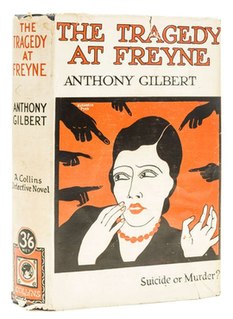
The Tragedy at Freyne is a 1927 mystery detective novel by Anthony Gilbert, the pen name of British writer Lucy Beatrice Malleson. Her first novel under the pseudonym, it introduced the amateur detective Scott Egerton who was her principle character until the creation of Arthur Crook in Murder by Experts.
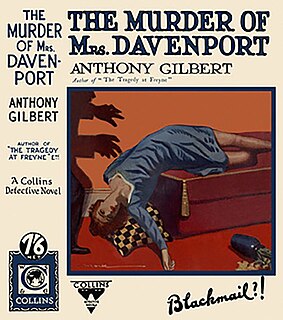
The Murder of Mrs. Davenport is a 1928 mystery detective novel by Anthony Gilbert, the pen name of British writer Lucy Beatrice Malleson. It was the second novel featuring her amateur detective Scott Egerton.

Death at Four Corners is a 1929 mystery detective novel by Anthony Gilbert, the pen name of British writer Lucy Beatrice Malleson. It is the third novel in a series featuring her amateur detective Scott Egerton.

The Night of the Fog is a 1930 mystery detective novel by Anthony Gilbert, the pen name of British writer Lucy Beatrice Malleson. It is the fifth of ten novels in a series featuring her amateur detective and politician Scott Egerton, a precursor to her better known creation Arthur Crook.

The Body on the Beam is a 1932 mystery detective novel by Anthony Gilbert, the pen name of British writer Lucy Beatrice Malleson. It is the sixth of ten novels in a series featuring her amateur detective and politician Scott Egerton, a precursor to her better known creation Arthur Crook.

An Old Lady Dies is a 1934 mystery detective novel by Anthony Gilbert, the pen name of British writer Lucy Beatrice Malleson. It is the ninth of ten novels in a series featuring her amateur detective and politician Scott Egerton, a precursor to her better known creation Arthur Crook. It was reviewed in the Sunday Times by Dorothy L. Sayers.

The Man Who Was Too Clever is a 1935 mystery detective novel by Anthony Gilbert, the pen name of British writer Lucy Beatrice Malleson. It is the tenth and last in a series of novels featuring her amateur detective and politician Scott Egerton. The following year she introduced a new character, the unscrupulous solicitor Arthur Crook, in Murder by Experts.

Something Nasty in the Woodshed is a 1942 mystery detective novel by Anthony Gilbert, the pen name of British writer Lucy Beatrice Malleson. It is the tenth in her long-running series featuring the unscrupulous London solicitor and detective Arthur Crook. In 1942 it was published in America under the alternative title Mystery in the Woodshed.
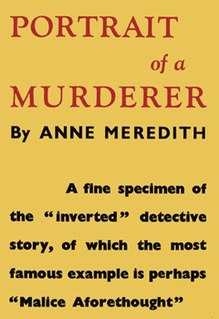
Portrait of a Murderer is a 1933 detective novel by Anne Meredith, the pen name of British writer Lucy Beatrice Malleson best known for writing as Anthony Gilbert. It was a stand-alone novel by the author at the time known for her series featuring Scott Egerton and later for her Arthur Crook mystery thrillers. It was reissued in 2017 by British Library Publishing. It broadly takes the structure of an inverted detective story, as from near the beginning the identity of the murderer is revealed.
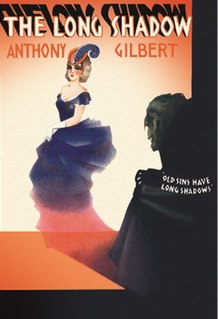
The Long Shadow is a 1932 mystery detective novel by Anthony Gilbert, the pen name of British writer Lucy Beatrice Malleson. It is the seventh of ten novels in a series featuring her amateur detective and politician Scott Egerton, a precursor to her better known creation Arthur Crook.
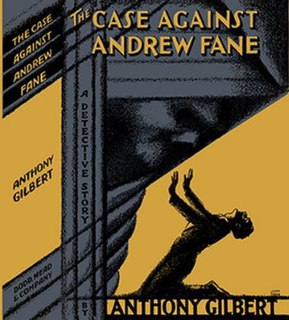
The Case Against Andrew Fane is a 1931 mystery detective novel by the British writer Anthony Gilbert, the pen name of British writer Lucy Beatrice Malleson. It was a stand-alone novel by the author who was at the best time known for her Golden Age detective Scott Egerton.

Death Knows No Calendar is a 1942 detective novel by the British writer John Bude. It was a stand-alone novel rather than one featuring his regular detective Superintendent Meredith. In this case the investigation is led by a former army officer Major Boddy. It takes the former of a locked room mystery with a closed circle of suspects, both popular variations of the genre during the period. Originally published by Cassell, in 2020 it was reissued by the British Library Publishing in a single edition with another Bude novel Death in White Pyjamas, as part of a series of republished crime novels from the Golden Age of Detective Fiction.



















